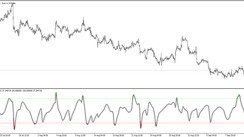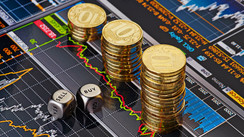Embarking on the journey of day trading can be exciting for new traders, but it also brings with it a wealth of decisions to be made. One such decision pertains to which time frames to monitor while day trading stocks. Would tick charts and a five-minute chart for context serve you best? Or perhaps, would a one-minute chart provide the clarity you need? And then there's the question of whether a 15-minute or hourly chart would be more useful for keeping an eye on significant support or resistance levels that have developed over the past few days.
These are all valid questions and considerations. However, it's crucial to remember that the optimal time frames for monitoring and trading should be outlined in your trading plan. A trading plan serves as a roadmap, guiding your trading activities based on a predefined set of criteria and strategies. If you haven't yet created a trading plan, this is an excellent opportunity to dive deeper into your options for day-trading strategies.
For those with a trading plan already in place, it's time to let go of the confusion and gain a clearer understanding of the best time frames to monitor while day trading. Time frames are not a one-size-fits-all concept in trading. Your choice of time frame can significantly influence your perception of the market and, in turn, your trading decisions. Therefore, understanding how different time frames work and how to use them effectively is an essential step towards becoming a successful day trader.
Your trading time frames should align with your trading strategy, your personal trading style, and the level of trading detail you are comfortable with. Remember, successful day trading is about consistency and finding a strategy and time frame that works for you and sticking with it.
Essential Observations for Effective Trading
- The selection of chart time frames alters the information intervals and the quantity of information you observe.
- During periods of high trading volume, it is advisable to increase your time frame to decrease the level of detail.
- Conversely, during periods of low trading volume, a reduction in your time frame can enhance detail.
- As the trading day progresses, lengthen your time frames to monitor trends.
The Relationship Between Chart Time Frames and Market Volatility
Don't be misled by the statement "One-minute charts are too volatile". The way data is viewed does not change a market's volatility. It only alters the amount of information you see.
Tick charts display the maximum data since they generate a bar for each transaction (or a specific number of transactions, like 30 or 500). The one-minute chart displays price movement during each one-minute period. Similarly, a five-minute chart indicates price movement in five-minute intervals. The one-minute chart may seem more erratic, but that's merely because it divulges more detail about trading.
Selecting Appropriate Time Frames
Time frames don’t influence the information you see; they merely present the information differently. Shorter time-frame charts expose more detail, while longer-term charts show less detail. However, the detail is still present in the long-term chart. The chart simply broadens the view to highlight long-term trends over short-term detail.
For stock day trading, monitor a tick chart at the open of the market. A huge number of transactions occur around this time. These are all tradable moves, but they happen so quickly that if you're viewing a one-minute chart, you might miss them.
As the day progresses, your tick chart will accumulate many bars. If the detail becomes too overwhelming, it's beneficial to open a one-minute or two-minute chart. These charts offer a summary of the tick chart, providing traders with more context about the activity.
Take A Break Then Continue Lengthening Your Time Frame
Most day traders operate near the open but stop trading around 11:00 or 11:30 a.m. ET, just before the New York lunch hour. Day traders typically take a break, as fewer quality trade opportunities are available during this quieter period.
Towards the end of the day, it's beneficial to have a four-minute or five-minute chart open. These charts will help showcase the day's overall trend and make significant support and resistance levels clearly visible.
Monitoring Prior Days: An Occasional Need
For the most part, day traders invest their energy in interpreting current data. As the name implies, day trading is concerned with the daily ebbs and flows of the stock market. At the start of the day, traders will analyze what happened in the pre-market and perhaps consider some elements of the previous session, but generally, that's the extent of their historical analysis. This approach is intentional and strategic. Day traders must remain alert and responsive to what is happening now. Dredging through heaps of historical data isn't likely to yield much information of value to a day trader.
However, there are occasions when a day trader might need to take a peek at what transpired on previous days. This occurs when their individual trading strategy necessitates it. For example, a trading strategy known as the "dead cat bounce" seeks trading opportunities based on price gaps. In this case, signals for this strategy may manifest days after the price gap occurred, so identifying these trade signals relies on the utilization of a chart that encompasses several days of price history.
Final Thoughts
In conclusion, for the majority of stock day traders, a tick chart will be the go-to option for placing trades. The tick chart presents the most granular information and provides more potential trade signals when the market is active, relative to a one-minute or longer time frame chart. Moreover, it also efficiently highlights periods when there is scant activity.
While the tick chart should be a constant in your trading strategy, it's equally important not to let it monopolize your attention. Given its level of detail, you may not be able to see all the price data for the current day on your tick chart. Keeping an eye on the day's broader trends, overall volatility, tendencies, and strong intra-day support and resistance levels is essential. To reveal all the price data for the day, consider having a separate one-minute or two-minute chart open to reveal the entire day's price action.
As the trading day unfolds, the need may arise to expand the time frame of your chart to encompass the whole day's activities. When doing this, it's not the specific time frame that matters most, but rather the ability to see as much detail as possible while still being able to view the entire day's price action. While more detail becomes visible in shorter time frames, fitting an entire day of action onto a single chart becomes increasingly challenging.
Even though you'll extend your time frame later in the day, there's no need to stress over monitoring longer time frames (15-minute, hourly, or daily charts), unless your strategy explicitly requires it. In that situation, open a separate chart for that time frame. The fundamental goal is to keep your trading straightforward and uncomplicated. Stay focused on the present day and what is happening in the now. The art of day trading is a dance with the present moment, so keep your attention on the beat of today's market.
Remember, the objective is to keep your trading simple. Concentrate on the present day and what is happening now.
Frequently Asked Questions (FAQs)
- How can you utilize candlestick charts in day trading? Each candlestick provides five pieces of information that can assist your trading strategy.
- Where can you access candlestick charts for day trading? Several brokerages offer these charts, along with sites like TradingView and Yahoo Finance.
- What charts should you use for day trading forex or cryptocurrencies? Day-trading strategies are not exclusive to a specific type of security, so the guidelines for stock day traders are applicable for forex or cryptocurrency traders.





